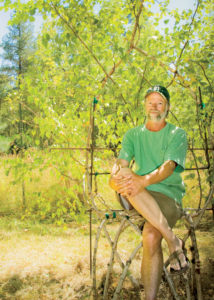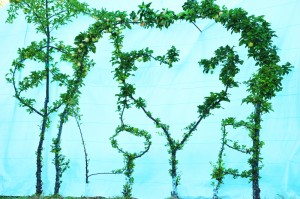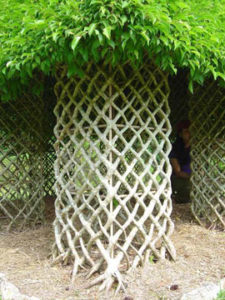Life and Limbs
For arborsmith Richard Reames, art is quite literally alive.
By Jamie Cole | Photos By Peter Marbach and Courtesy of Richard Reames
Richard Reames arrives on the Nashville stage with pruners, a knife, stretch tape and a few long pieces of 2 x 2. A huge plastic pot is already center stage, under the lights, with three metal bars on the ground next to it. Inside the pot are several tree saplings, about six feet tall. They’re bare, “unbranched,” looking like the “switches” a mother might gather to set straight a wayward child.
Reames pulls a roll of tie wire from a pocket in his cargo pants. A few nails come from another pocket as he yanks a hammer from a loop on his waist. Within minutes, he builds a frame around the pot: three straight sticks in the back, two on the sides, with the metal bars laid across the sticks and tied with the wire. The shape is roughly that of a chair, and you can see that’s where Reames is headed with the project.
He wipes his hands on his white T-shirt and starts to bend, stretch and weave the saplings. The work is organic, yet precise. He pulls the tops of the saplings on the back of the frame, taut as a stand-up bass—like if you plucked them, they’d hum. He uses the knife to make tongued notches that slide together where some of the branches cross. He binds those tiny wounds with the stretch tape to secure these intersections; they will grow into grafts.
Reames looks like the cool guy in the park, the one that might go flitting by your picnic with the flip of a Frisbee and a whiff of patchouli. He’s tall, lean, bearded and pony-tailed. He calls his time on stage a “lecture,” but he could call it any number of things. It’s performance, as intriguing as a good play. It’s a building demonstration, as practical as the ones put on by big-box home improvement stores. As much as Reames himself stands out, the title of his “lecture” draws your eye on the Nashville Lawn and Garden Show’s program. There it is, just below the heirloom vegetable cooking demonstration and above the talk about garden bugs from the county Extension agent:
“How To Grow a Chair,” with Richard Reames.
This skill, which Reames teaches at garden shows, fairs and folk art festivals around the country, is so unique, he had to create a new word to describe it: “arborsculpture.” It is somewhat related to topiary and bonsai, two popular and widely practiced “tree arts.” But they’re distant cousins. This isn’t clipping a hedge into shapes or trimming tiny, delicate branches for display. This is manipulating the living trees themselves—the trunks, the branches, everything—and training them to grow into something beautiful, functional, or both. In a few years, the saplings Reames trains on stage today will grow in, around and through each other, swallowing the simple frame he built. The living chair can be planted in a garden and will continue to grow, a conversation piece for generations.
Reames explicates some of the specifics: using a hand-over-hand technique to make bends in thicker branches; making a break that, with nursing, will become a strong right angle; rubbing off tiny buds instead of cutting them to minimize trauma to the sapling. Sometimes a branch will cooperate, sometimes it will not. He waxes philosophical for a moment, and says arborsculpture is a conversation, often an argument, with nature. If this at-one-with-nature routine is off-putting to the magnolia-and-mint-julep crowd in Nashville, they’re not showing it.
Reames wraps up his lecture with a slide show that has his audience rubber-necking and occasionally gasping. Making a living chair is one thing, but the way the trees are manipulated in these images is stunning. Trunks with four legs and elaborate trellises flash by. Some of these shapes—wheels, webs, weaves—would be difficult to carve, much less sculpt. Some designs look tortured, some look downright bizarre.
All of them look like products of a wild imagination. “Only God can make a tree,” the poet said. Well, Mr. Joyce should have met Mr. Reames, who can make something out of a tree—and he doesn’t even have to cut it down first.
—-
Reames may have named arborsculpture, but he didn’t invent it. It’s hard to say who did, but for Reames, the direct inspiration comes from two 20th century farmers. That shouldn’t be a surprise, Reames says. Farmers have a kinship with the land and what emerges from it. “They’re observant,” says Reames. “A farmer sees two trees growing together in a hedgerow, it inspires him, and he sees potential.”
John Krubsack, a farmer and banker outside the logging town of Embarrass, Wisconsin, saw the potential in the early 1900s. “One of these days I am going to grow a piece of furniture that will be better and stronger than any human hands can build,” he once told a friend. Krusback’s son wrote of his father’s “living chair” in letters to family, and photos exist of the elder Krusback seated in his creation, which he “harvested” so that it could be moved away from its trunk, even indoors, while leaving all of its grafts intact. The harvested chair was displayed at the 1915 World’s Fair, and the same piece was photographed as late as 1988 at Disneyworld in Orlando, with Mickey Mouse perched on its still-sturdy frame.
Axel Erlandson may have known about Krusback’s chair, but it was a hedgerow of trees growing together naturally around one of his fields that inspired him to graft and weave trees into preconceived designs. Erlandson’s farm in the mountains around Santa Cruz, California, where he grew beans and alfalfa hay for a living, soon became ground zero for his tree design and manipulation experiments. Erlandson may have grown a chair at some point in his life—there’s a photo of him sitting in one, taken sometime in the 1950s—but his passion was intricate, artistic designs. Erlandson’s trees looked perfectly normal on top, but the trunks were manipulated into all manner of shapes—lattices, ladders, hearts, curly-cues. None of it was carved. All of it was grafted or somehow, near impossibly, bent into the structure of the tree itself. And on top of that, his trees continued to grow, and the shapes evolved and strengthened as the trunks expanded.
Erlandson’s wife encouraged him to put his trees on public display, though it’s unclear whether she was enamored with his work or frustrated by a lack of income. Erlandson’s “Tree Circus” was a spectacular failure as a roadside attraction, in spite of being on the major highway that led tourists into the pastel-colored, seaside vacation village of Santa Cruz. In fact, Erlandson was more successful selling picture postcards of his trees than in drawing folks to visit the real thing. Still, he had a sense that he was advancing an art form. “I have learned a kind of profession so late in life that I cannot carry it to near its possible attainment,” he wrote in 1953. Erlandson let go of the dream in 1963, selling the Tree Circus property and its dozens of sculpted trunks to a real estate broker named William Thompson, who turned the park into an attraction called “The Lost World.” Erlandson died less than a year later.
—-
Reames, born in 1957 just a few years after Erlandson lamented his lack of a successor, grew up near Santa Cruz, 10 miles from Erlandson’s venture. He doesn’t remember seeing the trees as a child. The Lost World became a smashing success in the intervening years, but not because of Erlandson’s creations. “I remember the dinosaurs,” says Reames, recalling the huge fiberglass creatures William Thompson commissioned after buying the property from Erlandson. The dinosaurs made the trees an afterthought, and many of Erlandson’s ornate creations died or were even bulldozed. A few of the trees survive today, though; they were moved inland at great expense in the 1980s and are now one of the main attractions at Bonfonte Gardens in Gilroy, California.
Reames admits those trees might have planted some subconscious seed, but it was his mother who nurtured his love of nature. “We did a little vegetable garden together,” he says, “and since my mother liked to live rural, it was an easy walk for me into the fields and down to the river.”
Reames wanted to study botany and horticulture in college, but he rejected the structure of the educational establishment. For more than a decade, he crisscrossed the country in a 1969 Chevy van—that, or he hitchhiked—taking work as an itinerant landscaper. “I could always check in back home in Santa Cruz,” he says, “but I was ‘volunteer homeless.’ A real gypsy.”
He won’t say whether he found himself in those travels, but he did eventually find himself wanting to settle down. The idea of fatherhood appealed to him. In 1991, he met a girl named Maya Many Moons at a community dance in southwest Oregon. It intrigued him that this pretty Anglo-Saxon adopted the name out of fascination with the Mayans of the Yucatan. They married, and were able to buy some land in cooperation with another couple. This new home place, tucked between the tiny town of Williams, Oregon, and the border of Klamath National Forest, was “heaven,” Reames says. “Imagine being on the road for 10 years, then having your own piece of land.”
Parenthood came quickly, at the same time Reames was building a house on the property by hand. No pre-fab building materials for him and Maya, though; the foundation was native stone and the walls were crafted in a piece-on-piece, log-cabin style from dead-standing trees. Daughter Myray was born just as the third wall of the octagon-shaped house was going up, and she spent her time as a toddler with Mom and Dad in the woodstove-heated cabin, completely off the grid. “We started with kerosene lamps, then got some solar panels,” says Reames. “Before long, we had all the conveniences everyone else did; we just got them in different ways.”
Myray’s arrival cured the gypsy in Reames. Living off the grid was nice, “a luxury,” he says, but a child brings the necessity of a steady income. “I needed a clear focus; I needed to make something of my life,” he says. “My habit is to clear my mind, take a long walk in the woods and ask for what I’m looking for.” Ask who? “Just ask,” he says.
The answer came immediately, he says, in the form of Erlandson’s picture postcards. “I’d seen them. I don’t know if it was when I was a child or later. But when those photographs came to mind, I knew that’s what I wanted to do.” Just as Erlandson had predicted, “no one had pursued it,” says Reames. “It was going to be a lost art if no one did. I felt the time was right.”
Reames’ epiphany coincided with the emergence of a new medium, and he recognized the importance of getting on the grid and, specifically, the Internet. In 1995 he wrote the book that would become the subject of his lectures, How To Grow a Chair, and marketed it online. In its pages, he coined the term “arborsculpture,” and christened himself an “arborsmith.”
The book’s success led to “installations” at first: Reames would show up at a client’s property and start an arborsculpture project, then train the new owner in its care. Gardens all over the West Coast exhibit Reames’ originals, which the owners must continue to train and maintain. Next came the lecture and teaching circuit. With all of this came the income, the notoriety, and the life Reames wanted for his family—a continuance of the life Axel Erlandson tried to build, down the coast and years ago near Reames’ childhood home.
—-
In the main room of his cabin, Reames has a wall of small arborsculpture pieces that were harvested out of necessity. “This is a wall of projects that died,” he says. “I brought them in, and I keep them dry so they don’t rot. Eventually there will be enough for a big gallery show.”
There’s already a big show outside the cabin, in the yard. There are loops, patterns and shapes in trunks that would make Axel Erlandson proud; a peace sign is one of Reames’ favorite designs. But the Reames’ home place isn’t open to the public. Reames maintains these specimens for himself and his family.
Past the irrigation ditches that help him water his collection is a vast stand with hundreds of saplings—diminutive birches, alders, poplars. They’re cultivated as stock for lectures, Reames’ private projects and client installations. If it’s a living chair you’re after, a visit from Reames will run about $1,500, plus travel expenses for Reames and a maintenance investment the client will pay out in years.
Reames is most proud, he says, of a tree house he’s growing at his place. It’s 15 feet off the ground. Its only guides are a plywood floor and a simple frame. It’s an experiment of sorts, a move toward a weather-tight structure that’s both livable and alive. It’s also representative of a bigger idea for Reames’ art.
His second book, 2007’s Arborsculpture: Solutions for a Small Planet, seems to put forth a loftier goal in its very title. For Reames, the book was an exercise in genealogy, a family tree of arborsmiths dating back to the Druids, and a history lesson. It turns out there were arborsmiths who thought bigger than Krubsack and Erlandson. Reames’ research for the book turned up Arthur Wiechula, a German contemporary of Krubsack, who self-published a book called “Developing Houses From Living Trees.” The work was filled with wild sketches of living structures, from homes to bridges, meant to forward the vision, but the idea is impractical, says Reames. “Wiechula wasn’t much of a horticulturalist,” says Reames. “Structures get too big, there’s too much shade on one side, too much sun on the other, one or more trees die, affecting the engineering soundness of the structure,” he says. The time investment would be huge. If a chair takes a few years, imagine growing a house.
Wiechula didn’t understand the physical science behind living structures, either. “Growing trees exert a lot of force on their own, as far as pounds per square inch,” says Reames. “Then there are the external forces, like wind.”
He’s intrigued, though, by Wiechula’s ideas, and by the mainstream architects like the man himself, Frank Lloyd Wright, who wrote about the idea of organic architecture. “Wright’s style was to incorporate nature into the structure as best he could; to bring nature into the house,” Reames says. His tree house is a step in that direction, and maybe even an offshoot of Wiechula’s vision. “It’s arbortecture,” Reames says, ever expanding the vocabulary. And he finds himself thinking of new projects that might fit the arbortecture label. “A solid wall of living trunk, say 20 feet long, 10 feet high,” he says. Impossible? Maybe. “But,” he says, “I can think up 10 impossible projects before breakfast.”
—-
On a smaller scale, Reames revels in the practical, sustainable side of his art form. Horticulturalists have long practiced coppicing—cutting trees off at ground level where new shoots can emerge. The same happens when Reames harvests a small piece, like an arborsculptured chair, table or bench. A new one can grow back in its place.
It’s a heady idea. Ask Reames if he’s an environmentalist, and he’ll tell you he’s more of an optimist, preferring to stand outside of the arguing and fearmongering. “I don’t think there’s anything that can happen to this world that can’t be turned into a positive,” he says. “What I do with trees, it’s just one idea that can help. Everybody has a piece of the puzzle.”
Reames still travels for lectures, does the occasional installation and, of course, works on his own projects. He also embraces technology in a way that belies his gypsy past; his books sell well on Amazon.com, and he stays in contact with several hundred Facebook fans while reaching thousands more on his web site, arborsmith.com. Admirers find photos of him on both sites, showing off his work, often wearing a favorite T-shirt, screened with “I (Heart) Trees” on the front.
Environmentalist, optimist, whatever. He admits to being a tree hugger. His art, his profession, his passion—it all separates him from the derisive implication that term often carries. When he sits in one of his creations—a living chair, still growing imperceptibly but inevitably underneath him—the trees hug him back.










